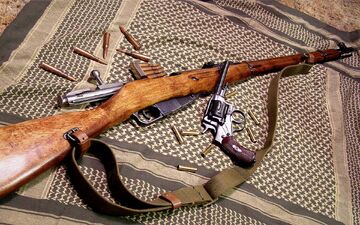
A Mosin-Nagant rifle and ammunition with an M1895 revolver.
The Mosin–Nagant (Russian: Винтовка Мосина, ISO 9: Vintovka Mosina) is a bolt-action, internal magazine-fed, military rifle chambered for the 7.62×54mmR round. The Mosin-Nagant was developed by the Imperial Russian Army in 1882–1891, and used by the armed forces of the Russian Empire, the Soviet Union and various other nations. The rifles are known for being loud and having a lot of recoil, but also powerful, accurate, plentiful and cheap. Many Mosins still covered in cosmoline could be found for around $100 a few years ago, but since then the surplus has become less plentiful and prices have risen slightly.
The Mosin-Nagant M91/30 was seen in Rambo III used by the Mujahideen rebels.
Description and History[]
The 3-line rifle, Model 1891, its original official designation, was designed by Captain Sergei Mosin and Léon Nagant. The Mosin-Nagant was adopted by the Russian military in 1891. There have been several variations from the original rifle, the most common being the M1891/30 (commonly referred to as "the 91/30" by shooters), which was a modernized design introduced in 1930. Some details were borrowed from Nagant's design. One such detail is the attachment of the magazine spring to the magazine base plate. In Mosin's original design the spring was not attached to the base plate and, according to the Commission, could be lost during cleaning. Another detail is the form of the clip that could hold five cartridges to be loaded simultaneously into the magazine. Another detail is the form of the "interrupter", a specially designed part within the receiver, which helps prevent double feeding. The initial rifle proposed by Nagant lacked an interrupter, leading to numerous failures to feed. This detail was introduced in the rifle borrowing from Mosin's rifle. Although the form of the interrupter was slightly changed, this alteration was subsequently borrowed back by the Commission for the Model 1891 Mosin-Nagant. During the modernization of 1930, the form of the interrupter was further changed, from a single piece to a two-piece design, as the part had turned out to be one of the least reliable parts of the action. Only the clip loading cartridges and the attachment of the magazine spring to the magazine base plate in subsequent models were designed by Nagant. Considering the rifle could be easily loaded without using a clip, one cartridge after another, the magazine spring attached to the magazine base plate is the only contribution of Nagant to all rifles after 1930.
By the end of the war, approximately 17.4 million M91/30 rifles had been produced. Roughly 37 million Mosin-Nagants have been built worldwide.
Popularity[]

Hamid with a Mosin-Nagant in Rambo III.
In the years after World War II, the Soviet Union ceased production of all Mosin–Nagants and withdrew them from service in favor of the SKS series carbines and eventually the AK series rifles. Despite its growing obsolescence, the Mosin–Nagant saw continued service throughout the Eastern bloc and the rest of the world for many decades to come. Mosin–Nagant rifles and carbines saw service on many fronts of the Cold War, from Korea and Vietnam to Afghanistan and along the Iron Curtain in Europe. They were kept not only as reserve stockpiles, but front-line infantry weapons as well.
Virtually every country that received military aid from the Soviet Union, China, and Eastern Europe during the Cold War used Mosin–Nagants at various times. Middle Eastern countries within the sphere of Soviet influence — Egypt, Syria, Iraq, Afghanistan and Palestinian fighters — have received them in addition to other more modern arms. Mosin–Nagants have also seen action in the hands of both Soviet and Mujahadeen forces in Afghanistan during the Soviet Union's occupation of the country during the 1970s and the 1980s. Their use in Afghanistan continued on well into the 1990s and the early 21st century by Northern Alliance forces.
Even after the collapse of the Soviet Union, Mosin–Nagants are still commonly found on modern battlefields around the world. They were used by insurgent forces in the Iraq War and the current war in Afghanistan. Mosin Nagant rifles have even been seen in the hands of rebels in the Syrian Civil War as well as in the hands of combatants in the current conflict in eastern Ukraine. Separatists have also used the rifles alongside more modern Russian firearms in the Second war in Chechnya, and, even today, it seems that some 91/30 PU sniper rifles remain in service and are used on the field by Russian police, Spetsnaz, paramilitary factions in Chechnya, and other Caucasus republics, like Dagestan and Ingushetia. In addition, scoped Mosins continue to serve as issue sniper rifles with the Afghan Army, the Iraqi Army, the Finnish Army, and with a micrometer sight as a sniper training and precision target rifle with the Finns.
In preparation for a future war with the Western world (and China after the Sino-Soviet split), many of the M91/30s (along with the M38 and M44 carbines) were lathered in rust preventing cosmoline and stocked in warehouses for future use. Decades later, after the breakup of the Soviet Union, the surplus Mosins were unpacked and shipped overseas for very cheap to people in America, Canada and Australia. The surplus rifles with surplus ammunition became very popular for being cheap, reliable, accurate and plentiful. Mosins are still popular in the West today, even though the surplus is not what it once was.
